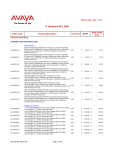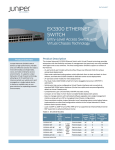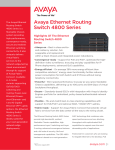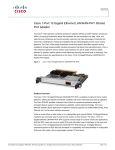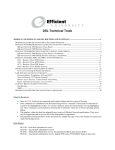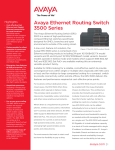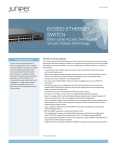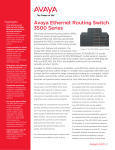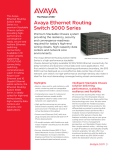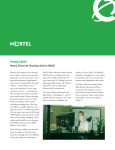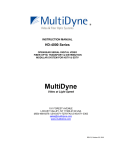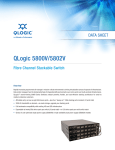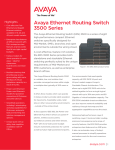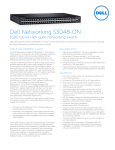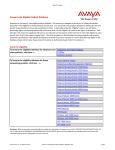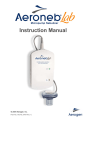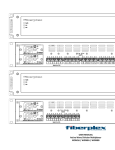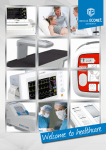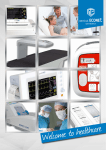Download Avaya 450W AC F-B
Transcript
The Avaya Ethernet Routing Switch 5900 Series is a premium Stackable Chassis system providing highperformance, convergence-ready, resilient and more secure Ethernet switching connectivity. Supporting Avaya Fabric Connect, it also delivers virtual fabric services to the network edge / wiring closet environment. Available in 4 model variants supporting 10/100/1000 switching and routing, 40 uplink capacity Gbps (4 x SFP+) and Powerover-Ethernet+, the Ethernet Routing Switch 5900 is ideally suited for high-end wiring closet and network edge deployments. Avaya Ethernet Routing Switch 5900 Series Highlights of the Ethernet Routing Switch 5900 •Always-on – Best in class end-to-end resiliency solution, hot-swappable unit replacement within a Stack Chassis and integrated power redundancy. •Convergence-ready – Support for PoE and PoE+, optimized for high-definition video surveillance, true plug and play capabilities for IP Phone deployments, advanced QoS capabilities. •Powerful – Wire-speed performance, true pay-as-you-grow Stackable Chassis capabilities, delivering up to 400 ports, 672 Gbps of virtual backplane throughput, and up to 40 Gbps uplink capacity. •Fabric-enabled – Support for Avaya Fabric Connect that extends virtual fabric services from the data center all the way to the wiring closet. •Comprehensive Layer 3 Services – Advanced routing features enable traffic segregation ideal for network distribution and core applications. •Mitigates Risk – Standards-based IEEE 802.1x with integration with Avaya’s Identity Engines portfolio for centralized, policy-based authenticated network access. Also MACSec-ready (IEEE 802.1AE) for encryption-based protection services.1 •Flexible – Mix-and-match best-in-class stacking capabilities with support for PoE/PoE+ and optional 1GbE / 10GbE SFP+ uplinks. The Ethernet Routing Switch 5900 Series provide resilient Stackable Chassis capabilities, high-performance Layer 2 switching, Layer 3 routing, advanced convergence features and a full suite of security, QoS and management capabilities. •High-end wiring closet – with advanced convergence features, including PoE/ PoE+, QoS, comprehensive security risk mitigation and up to 40 Gbps uplink capacity, the ERS 5900 is a flexible highperformance switching option for converged edge deployments. The ERS 5900 hardware is based on nextgeneration ASIC technology that combines wire-speed performance and non-blocking throughput with sophisticated QoS capabilities to support even the most demanding suite of applications. It can be positioned for a variety of customer scenarios, including: •Network distribution switch for campus – its Layer 3 routing services and highperformance make the ERS 5900 a powerful aggregation or distribution solution for both mid-market and large enterprises. It can connect either to core switches or directly to data center servers while reducing latency and providing high end-to-end performance. avaya.com | 1 Intelligent Stackable Chassis solution delivering performance, scalability, resilience and flexibility ERS 5900 Series Models Avaya introduced its first Stackable Chassis product in 1998 and we’ve been perfecting the technology ever since. We offer genuine chassis-like features including true pay-as-yougrow scaling, in-stack switch replacement and restoration. From a Avaya Ethernet Routing Switch 5900 Series Model Link and Uplink Ports ERS 5928GTS 24 x 10/100/1000BASE-T ports, plus 4 x SFP+ uplink ports ERS 5928GTS-PWR+ 24 x 10/100/1000BASE-T ports supporting 802.3at PoE+, plus 4 x SFP+ uplink ports ERS 5952GTS 48 x 10/100/1000BASE-T ports, plus 4 x SFP+ uplink ports ERS 5952GTS-PWR+ 48 x 10/100/1000BASE-T ports supporting 802.3at PoE+, plus 4 x SFP+ uplink ports management perspective, our Stackable Chassis looks like a single network entity – utilizing only a single IP address to dramatically simplify software upgrades. High performance architecture with true pay-as-you grow scaling the backbone. In addition to the a like-for-like unit is inserted, cabled, stacking cables, a return cable is also and powered-up. The Automatic Unit used to protect against any port, unit Replacement (AUR) process self- or cable failures. manages software and configuration Our Stackable Chassis products downloads to the new switch then combine non-blocking internal brings it online, without the need for switching fabrics with high-speed an engineer to configure or manage virtual backplane architecture to the process. deliver a high performance solution that scales proportionally as new Further complementing the Stackable switches are added. The ERS 5900 Chassis architecture, the Avaya ERS Series can scale up to 672 Gbps of 5900 Series supports standards- virtual backplane throughput by based 802.3ad Link Aggregation as simply cabling together up to 8 units. Adding a new unit to the Stack Chassis is as easy as cabling in a new Figure 1. ERS 5900 stack back view with stacking cables, fans and power supplies well as its own Multi-Link Trunking technology that allows grouping of links to form high-speed trunks/ aggregations. Groups of links appropriate configuration. The In-stack switch replacement and restoration necessary software images and the Virtual hot swap capabilities enable device can be aggregated (or configuration file are automatically any failed switch unit of the Stackable trunked) to enhance bandwidth and downloaded to the new unit and then Chassis to be quickly and easily resiliency through active redundant brought on-line without any user replaced with a like-for-like switch links. Additionally, trunked links can intervention. without any impact to the existing span different units in the same traffic or any units. If a failure occurs, Stackable Chassis, enabling more fail- All ERS 5900 models come with two neighboring switches automatically safe connectivity to mission critical in-built Stackable Chassis interfaces wrap their fabric connections so that servers and the network core. for simple, cost-effective and efficient other switches within the Stackable connectivity. Unlike comparative Chassis are not impacted. The failed offerings which daisy chain low-speed unit is simply disconnected from the interfaces, this design frees uplink virtual backplane and, without pre- ports for dedicated connectivity to staging of software or configuration, member, then extending the 2 | avaya.com between the ERS 5900 and another Stack health-check monitoring, a realtime, at-a-glance view of operational status and health further enhances operational and management simplicity. Redundant power support The ERS 5900 models support field- Support for IEEE 802.3at PoE+ to power your device Comprehensive QoS capabilities replaceable AC power supplies for Through support for IEEE 802.3at The ERS 5900 series delivers the improved redundancy and uptime. PoE+ which delivers up to 32 Watts of quality of service control needed for This power supply design offers N+1 power per port to end devices, ERS networks with a wide range of power redundancy and/or 5900s are able to power IP phones, different application types. The ERS supplementary PoE/PoE+ power wireless LAN access points, 5900 classifies, prioritizes and marks budget, saving valuable rack space networked high-definition CCTV LAN IP traffic using up to four and enabling reduced system cameras and other devices. This hardware queues on every port – servicing and sparing costs. Non- eliminates the need for separate including the rear SFP ports. power models utilize two 450 Watt power supplies for each unit, enabling Power Supply Units for redundancy, reduced cabling and management and PoE+ models utilize two 1400 costs for adds, moves, or changes. Watt Power Supply units for redundancy. Front-to-back and back-tofront cooling options The ERS 5900 is designed to support then specific environmental needs of the wiring closet or data center with both front-to-back and back-to-front cooling options in its fan trays and power supplies. This gives users the flexibility to conform to a variety of hot-aisle/cold-aisle deployment requirements. Centralized management From a management perspective, our Stackable Chassis appears as a single networking entity – utilizing only a single IP Address. This can significantly reduce the number of Classification can be based on MAC address, IP ToS/DSCP marking, IP source/destination address or The 24-port and 48-port PoE+ subnets, TCP/UDP source/destination enabled products (ERS 5928GTS- port/port range, IEEE 802.1p user PWR+ and ERS 5952GTS-PWR+) priority bits, ingress source port, IP support a maximum power budget of Protocol ID (e.g., TCP, UDP, IGMP), 800 Watts on a single power supply – EtherType (e.g., IP, IPX) or the IEEE enabling full 32 Watts of power on up 802.1Q VLAN ID. Comprehensive to 24 PoE+ enabled access ports. traffic policing and traffic shaping are With a secondary/redundant supply, also supported. full PoE+ power can be delivered to all 48 access ports. Plug and play for IP phones Avaya Fabric Connect to the Wiring Closet One of the main benefits offered by All ERS 5900 models support Avaya the ERS 5900 Series is plug and play Fabric Connect enabling fabric support for IP phones enabled services to be extended from the through a combination of IEEE Data Center all the way to the campus 802.1ab Link Layer Discovery Protocol edge wiring closet. Based on an (LLDP) and Avaya’s Auto Discovery enhanced implementation of Shortest and Auto Configuration (ADAC) Path Bridging, an open, standards- capability. based and extensible fabric switches to be managed within the With these features enabled, the ERS network as a stack of up to 8 switches 5900 can automatically provision end can be managed just as easily as a devices such as IP Phones for single switch. simplified deployments and moves. The ERS 5900 dynamically applies Convergence-ready for UnifiedCommunications, High-Definition Video and more the correct VLAN and QoS to both For businesses looking to consolidate QoS is automatically provisioned on all forms of communication – voice, the ERS 5900 uplink so that voice is video and data – on a single given top priority from the wiring infrastructure, the Avaya ERS 5900 closet to the network core. These Series delivers functionality that features save network operators time simplifies convergence of these and can dramatically reduce the technologies. likelihood of a provisioning error the IP phone and the attached edge port. When the phone is moved to another location, the configuration is automatically updated. In addition, during a large IP phone deployment. technology, Avaya Fabric Connect delivers an array of network services while providing a consistent enterprise-wide virtualization architecture that is simpler, more adaptive and reliable. With support on the ERS 5900, fabric services are delivered on a campus-grade stackable access switch and can be extended much closer to where applications and users actually connect to the network. The result is simplified provisioning of applications or services at a point much closer to their entry into the network – eliminating complex hop-by-hop configuration and improving overall network resiliency. avaya.com | 3 Securing access at the edge Energy Efficiency Lifetime Warranty New regulations and rising awareness Avaya includes industry-leading The Ethernet Routing Switch 5900 of the ever-increasing cost of warranty services for our portfolio of offers a higher level of security risk electrical power keep energy stackable switches, including the mitigation through authenticated efficiency top of mind. An innovator Avaya ERS 5900 Series products. The network access that leverages IEEE in this area, Avaya has built energy warranty includes complimentary 802.1x (Extensible Authentication efficiency into many of its hardware next-business-day shipment of failed Protocol (EAP)) with extensions or products. In fact, independent testing units for the life of the product, and using a device’s MAC Address. indicates that Avaya LAN Switches, ongoing technical support. ERS 5900 Integration into Avaya’s Identity Call Servers, Gateways, Unified lifetime warranty also provides Engines portfolio for centralized, Messaging Servers and Gigabit IP complimentary access to new policy-based access control is Phones are typically more energy software releases. included along with more secure efficient than competitive equipment. management enabled through The ERS 5900 employs highly features such as Secure Shell (SSH), efficient power supplies and also Secure Sockets Layer (SSL), Simple supports dynamic power Network Management Protocol management where each port can be (SNMPv3), IP Manager List, Remote configured to limit the power Authentication Dial-In User Service delivered to a device and for power (RADIUS), and TACACS+ priority level—low, high, and critical. authentication. The ERS 5900 Series also offers numerous features that help prevent direct Denial of Service Attacks. Last but not least, ERS 5900 hardware is future-ready for MACSec (IEEE 802.1AE), which provides even Furthermore, the ERS 5900 supports Avaya Energy Saver which can further conserve energy by turning down port speeds during designated off- Summary Avaya is positioned to provide an end-to-end solution for converged networks. The Ethernet Routing Switch 5900 series, along with other Avaya products, can increase profitability and productivity, streamline business operations, lower costs and help your business gain a competitive edge. peak hours. higher levels of confidentiality and integrity for data traversing the network. Product Specifications ERS 5928GTS Switch Details 24 x 10/100/1000 Gigabit Ethernet ports Plus 4 x 1/10 Gigabit SFP+ ports Plus 2 x rear HiStack ports delivering up to 672 of Stackable Chassis throughput 1x out-of-band Ethernet port for management System CPU speed: 800 Mhz System Memory: 256 MB Flash, 1024 GB RAM Switch capacity and forwarding rate: 212 Gbps / 157 Mpps Ships with 1 set of 44 mm / 19’ rack mount brackets Dimensions: 4.4 cm – 1RU (H), 44.0 cm (W), 50.8 cm (D) Weight: 6.92 kg Power and Thermal Supplied with 1 x 450 watt Field Replaceable AC power supply Supports second Field Replaceable AC power supply for redundancy Power consumption: 90 watts Thermal rating: 307 BTU/hour 4 | avaya.com Product Specifications (cont.) ERS 5928GTS-PWR+ Switch Details 24 x 10/100/1000 Gigabit Ethernet ports supporting IEEE 802.3af PoE or IEEE 802.3at PoE+ 4 x 1/10 Gigabit SFP+ ports 2 x rear HiStack ports delivering up to 672 of Stackable Chassis throughput 1x out-of-band Ethernet port for management System CPU speed: 800 Mhz System Memory: 256 MB Flash, 1024 GB RAM Switch capacity and forwarding rate: 212 Gbps / 157 Mpps Ships with 1 set of 44 mm / 19’ rack mount brackets Dimensions: 4.4 cm – 1RU (H), 44.0 cm (W), 50.8 cm (D) Weight: 7.52 kg Power and Thermal Supplied with 1 x 1000 watt @120VAC or 1400 watt @220VAC watt Field Replaceable AC power supply Supports second Field Replaceable AC power supply for redundancy Power consumption: 230 watts @120VAC Thermal rating: 785 BTU/hour PoE power output: 720 watts with single power supply ERS 5952GTS Switch Details 48 x 10/100/1000 Gigabit Ethernet ports Plus 4 x 1/10 Gigabit SFP+ ports Plus 2 x rear HiStack ports delivering up to 672 of Stackable Chassis throughput 1x out-of-band Ethernet port for management System CPU speed: 800 Mhz System Memory: 256 MB Flash, 1024 GB RAM Switch capacity and forwarding rate: 260 Gbps / 193 Mpps Ships with 1 set of 44 mm / 19’ rack mount brackets Dimensions: 4.4 cm – 1RU (H), 44.0 cm (W), 50.8 cm (D) Weight: 7.11 kg Power and Thermal Supplied with 1 x 450 watt Field Replaceable AC power supply Supports second Field Replaceable AC power supply for redundancy Power consumption: 95 watts Thermal rating: 324 BTU/hour ERS 5952GTS-PWR+ Switch Details 48 x 10/100/1000 Gigabit Ethernet ports Plus 4 x 1/10 Gigabit SFP+ ports Plus 2 x rear HiStack ports delivering up to 672 of Stackable Chassis throughput 1x out-of-band Ethernet port for management System CPU speed: 800 Mhz System Memory: 256 MB Flash, 1024 GB RAM Switch capacity and forwarding rate: 260 Gbps / 193 Mpps Ships with 1 set of 44 mm / 19’ rack mount brackets Dimensions: 4.4 cm – 1RU (H), 44.0 cm (W), 50.8 cm (D) Weight: 7.11 kg Power and Thermal Supplied with 1000 watt @120VAC or 1400 watt @220VAC watt Field Replaceable AC power supply Supports second Field Replaceable AC power supply for redundancy Power consumption: 275 watts @120VAC Thermal rating: 938 BTU/hour PoE Power output: 800 watts @120VAC; 1200 watts @220VAC with single power supply avaya.com | 5 Ordering Information ERS 5900 Series Models AL59000?1*-E6 ERS 5928GTS featuring 24 x 10/100/1000BASE-T ports, plus 4 x SFP+ uplink ports AL59000?2*-E6 ERS 5928GTS-PWR+ featuring 24 x 10/100/1000BASE-T PoE+ ports, plus 4 x SFP+ uplink ports AL59000?3*-E6 ERS 5952GTS featuring 48 x 10/100/1000BASE-T ports, plus 4 x SFP+ uplink ports AL59000?4*-E6 ERS 5952GTS-PWR+ featuring 48 x 10/100/1000BASE-T PoE+ ports, plus 4 x SFP+ uplink ports Notes: • Each Switch ships with a Base Software License and either a 450W (for non-PoE units) or 1400W (for PoE+ units) Power Supply Unit • Stacking cables are not included and must be ordered separately • The eighth character (?) of the order number must be replaced with the proper letter to indicated desired product nationalization. • The tenth character (*) of the order number must be replaced with “F” for front-to-back or “B” for back-to-front cooling options Stacking Cables for ERS 5900 AA1404037-E6 0.5M Stacking Cable (QSFP+ to QSFP+) for ERS 5900 AA1404029-E6 1M Stacking Cable (QSFP+ to QSFP+) for ERS 5900 AA1404031-E6 3M Stacking Cable (QSFP+ to QSFP+) for ERS 5900 AA1404032-E6 5M Stacking Cable (QSFP+ to QSFP+) for ERS 5900 Power Supplies and Fan Trays for ERS 5900 AL7000?0B-E6 450W AC Power Supply with Back-to-Front Cooling AL7000?0F-E6 450W AC Power Supply with Front-to-Back Cooling AL1905?3B-E6 1400W AC PoE+ Power with Back-to-Front Cooling AL1905?3F-E6 1400W AC PoE+ Power with Front-to-Back Cooling AL5900BTF-E6 Fan Tray for Back-to-Front Cooling on ERS 5900 AL5900FTB-E6 Fan Tray for Front-to-Back Cooling on ERS 5900 Note: • The seventh character (?) of the Power Supply order number must be replaced with the proper letter to indicated desired product nationalization power cord option. Software for ERS 5900 380221 6 | avaya.com Advanced License for ERS 5900 (includes OSPF, PIM-SM, VRRP and ECMP) Technical Specifications ERS 5900 Series Models IEEE 802.1D Spanning Tree Protocol RFC 1724 / RFC 1389 RIPv2 MIB extensions IEEE 802.1w Rapid Spanning Tree RFC 1769 / RFC 1361 SNTP IEEE 802.1s Multiple Spanning Tree RFC 1886 DNS extensions to support IPv6 IEEE 802.1t 802.1D Maintenance RFC 1908 Coexistence between SNMPv1 & v2 IEEE 802.1p Prioritizing RFC 1945 HTTP v1.0 IEEE 802.1Q VLAN Tagging RFC 1981 Path MTU Discovery for IPv6 IEEE 802.1X Ethernet Authentication Protocol RFC 2011 SNMP v2 MIB for IP IEEE 802.1AB Link Layer Discovery Protocol RFC 2012 SNMP v2 MIB for TDP IEEE 802.1AX Link Aggregation Control Protocol (LACP) RFC 2013 SNMP v2 MIB for UDP IEEE 802.1ag Connectivity and Fault Management RFC 2096 IP Forwarding Table MIB IEEE 802.1aq Shortest Path Bridging MAC IEEE 802.3 Ethernet RFC 2131 / RFC 1541 Dynamic Host Configuration Protocol (DHCP) IEEE 802.3af Power over Ethernet RFC 2138 RADIUS Authentication IEEE 802.3at Power over Ethernet Plus RFC 2139 RADIUS Accounting IEEE 802.3ad / 802.1AX Link Aggregation Control Protocol LACP RFC 2236 IGMPv2 IEEE 802.3ab Gigabit Ethernet over Copper RFC 2453 RIPv2 IEEE 802.3ae 10Gbps Ethernet RFC 2454 IPv6 UDP MIB IEEE 802.3ak 10GBase-CX4 RFC 2460 IPv6 Specification IEEE 802.3i 10Base-T RFC 2461 IPv6 Neighbor Discovery IEEE 802.3u Fast Ethernet RFC 2464 Transmission of IPv6 packets over Ethernet IEEE 802.3x Flow Control RFC 2474 Differentiated Services (DiffServ) IEEE 802.3z Gigabit Ethernet RFC 2541 Secure Shell protocol architecture RFC 768 UDP RFC 2597 Assured Forwarding PHB Group RFC 783 TFTP RFC 2598 Expedited Forwarding PHB Group RFC 792 ICMP RFC 2616 / RFC 2068 HTTP 1.1 RFC 793 TCP RFC 2660 HTTPS - Secure Web RFC 826 ARP RFC 2665 / RFC 1643 Ethernet MIB RFC 854 Telnet RFC 2674 Q-BRIDGE-MIB RFC 894 IP over Ethernet RFC 2710 Multicast Listener Discovery version 1 (MLDv1) RFC 903 Reverse ARP RFC 2715 Interoperability Rules for Multicast Routing Protocols RFC 950 / RFC 791 IP RFC 2787 Definitions of Managed Objects for VRRP RFC 951 BootP RFC 2819 / RFC 1757 / RFC 1271 RMON RFC 958 NTP RFC 2851 Textual Conventions for Internet network addresses RFC 1058 RIPv1 RFC 2863 / RFC 2233 / RFC 1573 Interfaces Group MIB RFC 1112 IGMPv1 RFC 2865 RADIUS RFC 1122 Requirements for Internet hosts RFC 2866 / RFC 2138 RADIUS Accounting RFC 1155 SMI RFC 2869 RADIUS Extensions - Interim updates RFC 1156 MIB for management of TCP/IP RFC 2933 IGMP MIB RFC 1157 SNMP RFC 3058 RADIUS Authentication RFC 1212 Concise MIB definitions RFC 3140 / RFC 2836 Per-Hop Behavior Identification codes RFC 1213 MIB-II RFC 3162 RADIUS and IPv6 RFC 1215 SNMP Traps Definition RFC 3246 Expedited Forwarding Per-Hop Behavior RFC 1340 Assigned Numbers RFC 3260 / RFC 2475 Architecture for Differentiated Services RFC 1350 TFTP RFC 3289 DiffServ MIBs RFC 1354 IP Forwarding Table MIB RFC 3410 / RFC 2570 SNMPv3 RFC 1398 Ethernet MIB RFC 3411 / RFC 2571 SNMP Frameworks RFC 1442 SMI for SNMPv2 RFC 3412 / RFC 2572 SNMP Message Processing RFC 1450 MIB for SNMPv2 RFC 3413 / RFC 2573 SNMPv3 Applications RFC 1493 Bridge MIB RFC 3414 / RFC 2574 SNMPv3 USM RFC 1519 Classless Inter-Domain Routing (CIDR) RFC 3415 / RFC 2575 SNMPv3 VACM RFC 1591 DNS Client RFC 3416 / RFC 1905 SNMP RFC 1650 Definitions of Managed Objects for Ethernet-like Interfaces RFC 3417 / RFC 1906 SNMP Transport Mappings RFC 2328 / RFC 2178 / RFC 1583 OSPFv2 RFC 3418 / RFC 1907 SNMPv2 MIB avaya.com | 7 ERS 5900 Series Models (cont.) RFC 3484 Default Address Selection for IPv6 RFC 4293 IPv6 MIB RFC 3513 IPv6 Addressing Architecture RFC 4344 SSH Transport layer Encryption Modes RFC 3569 Overview of Source Specific Multicast (SSM) RFC 4345 Improved Arcfour Modes for SSH RFC 3579 RADIUS support for EAP RFC 3584 / RFC 2576 Co-existence of SNMP v1/v2/v3 RFC 4429 Optimistic Duplicate Address Detection (DAD) for IPv6 RFC 3587 IPv6 Global Unicast Format RFC 4432 SSHv2 RSA RFC 3596 DNS extensions to support IPv6 RFC 4443 / RFC 2463 ICMPv6 for IPv6 RFC 3621 Power over Ethernet MIB RFC 4541 Considerations for IGMP and MLD snooping switches RFC 3635 Definitions of Managed Objects for the Ethernet-like Interface Types RFC 4601 Protocol Independent Multicast – Sparse Mode (PIMSM) Protocol Specification RFC 3768 / RFC 2338 VRRP RFC 4604 / RFC 3376 IGMPv3 RFC 3810 MLDv2 for IPv6 RFC 4673 RADIUS Dynamic Authorization Server MIB RFC 3826 AES for the SNMP User-based Security Model RFC 4675 RADIUS Attributes for VLAN and Priority Support RFC 3917 Requirements for IPFIX RFC 4716 SSH Public Key File Format RFC 3954 Netflow Services Export v9 RFC 4750 / RFC 1850 / RFC 1253 OSPF v2 MIB RFC 3993 DHCP Subscriber-ID sub-option RFC 4789 SNMP over IEEE 802 Networks RFC 4007 Scoped Address Architecture RFC 4861 Neighbor Discovery for IPv6 RFC 4022 / RFC 2452 TCP MIB RFC 4862 / RFC 2462 IPv6 Stateless Address AutoConfiguration RFC 4113 UDP MIB RFC 4133 / RFC 2737 / RFC 2037 Entity MIB RFC 4193 Unique Local IPv6 Unicast Addresses RFC 4213 Transition Mechanisms for IPv6 Hosts & Routers RFC 4250 SSH Protocol Assigned Numbers RFC 5010 / RFC 3046 DHCP Relay Agent Information Option 82 RFC 5095 Deprecation of Type 0 Routing Headers in IPv6 RFC 5101 Specification of the IP Flow Information Export (IPFIX) Protocol for Exchange of IP Traffic RFC 4251 SSH Protocol Architecture RFC 5176 / RFC 3576 Dynamic Authorization Extensions to RADIUS RFC 4252 SSH Authentication Protocol RFC 5186 IGMPv3/MLDv2 and Multicast Routing Interaction RFC 4253 SSH Transport Layer Protocol RFC 5905 / RFC 4330 / RFC 1305 NTPv4 RFC 4254 SSH Connection Protocol RFC 6329 IS-IS Extensions Supporting Shortest Path Bridging RFC 4291 IPv6 Addressing Architecture General and Performance Switch Fabric performance: 212Gbps to 260Gbps LLDP Neighbors: up to 800 Frame forwarding rate: 157 to 193Mpps ARP Entries: up to 1,792 Stack Throughput: 672Gbps (8-unit stack) IP Interfaces: up to modified value Latency (64 byte packet): 3.5 microseconds IPv4 Routes: up to 512 Frame length: 64 to 1518 Bytes (untagged), 64 to 1522 bytes (tagged) OSPF Instances: up to 4 Jumbo Frame support: up to 9216 Bytes (tagged) ECMP Paths: up to 4 Multi-Link/LAG Trunks: up to 32 Groups, with 8 Links per Group VRRP Instances: up to 256 VLANs: up to 1,024 Port/Protocol IPFIX Sampled Flows: up to 100,000 Multiple Spanning Tree Groups: 8 Auto-MDIX MAC Address: up to 8k QoS Priority Queues: 8 DHCP Snooping: up to 1,024 table entries Enterprise Device Manager GUI, on-box & off-box 802.1X Clients: up to 768 8 | avaya.com OSPF Adjacencies: up to 16 Pluggable Interfaces 1000BASE-T SFP up to 100m over CAT5E or better UTP Cable (RJ-45) 1000BASE-SX SFP up to 550m reach on MMF (Duplex LC) 1000-BASE-LX SFP up to 550m reach on MMF, and up to 10 km on SMF (Duplex LC) 1000BASE-XD CDWM SFP up to 40 km reach on SMF (Duplex LC) 1000BASE-ZX CDWM SFP up to 70 km reach on SMF (Duplex LC) 1000BASE-EX SFP up to 120 km reach on SMF (Duplex LC) 100BASE-FX SFP up to 2km reach over MMF (Duplex LC) Ethernet-over-T1 SFP up to 2,874m reach over 22AWG Cable (RJ-48C) 10GBASE-SR SFP+ up to 300m reach over MMF (Duplex LC) 10GBASE-LRM SFP+ up to 220m over FDDI-grade MMF (Duplex LC) 10GBASE-LR SFP+ up to 10km reach over SMF (Duplex LC) 10GBASE-ER SFP+ up to 40km reach over SMF (Duplex LC) 10GBASE-X SFP+ Direct Attach Cables, in 3, 5, & 10m lengths 1000BASE-BX SFP up to 10 and 40 km reach variants on SMF (LC) Environmental Specifications Operating temperature: 0°C to 50°C (32°F to 122°F) Operating altitude: 0 to 3,048m (0 to 10,000ft) maximum Storage temperature: -40°C to 85°C (-40°F to 185°F) Acoustic Noise: less than 40dbA at 25°C; less than 53dbA at 50°C Operating humidity: 0 to 95% maximum relative humidity, noncondensing Safety Agency Approvals IEC60950 International CB Certification Anatel Brazilian Safety EN60950-1 Europe Safety (CE); CB Scheme Certification with Member Deviations ACMA-RCM Australia Safety UL60950-1 United States of America Safety CCC & MIIT China Safety CSA-C22.2, #60950-1 Canada Safety CNS14336-1 Taiwan BSMI Safety GOST-R Russia Safety NOM Mexico Safety EN60950-1 Japan Safety Electromagnetic Emissions & Immunity CISPR22 International EMC Emissions ACMA-RCM mark Australia EMC Emissions CIRPR24 International EMC Immunity Anatel Brazilian EMC Certification FCC part 15B, Class A USA EMC Emissions GOST-R Russia EMC Certification ICES-003 Class A Canadian EMC Emissions CCC & MIIT China EMC Certification VCCI Japan EMC Emissions KC mark: EMI & EMS Korean EMC Certification EN55022 Class A, CISPR22 European EMC Emissions (CE) CNS13438 Taiwan BSMI EMC EN55024, CISPR24 including EN61000-4-2, 4-3, 4-4, 4-5, 4-6, 4-8 & 4-11 European EMC Immunity (CE) 1 MACSec capabilities to be enabled in a future ERS 5900 software release avaya.com | 9 About Avaya Avaya is a leading, global provider of customer and team engagement solutions and services available in a variety of flexible on-premise and cloud deployment options. Avaya’s fabric-based networking solutions help simplify and accelerate the deployment of business critical applications and services. For more information, please visit www.avaya.com. 10 | avaya.com © 2015 Avaya Inc. All Rights Reserved. Avaya and the Avaya logo are trademarks of Avaya Inc. and are registered in the United States and other countries. All other trademarks identified by ®, TM, or SM are registered marks, trademarks, and service marks, respectively, of Avaya Inc. 03/15 • DN7705










